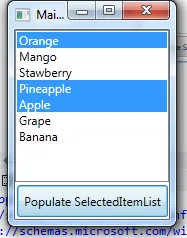您可以为
ListBox 创建一个
List AttachedProperty,当列表更改时,它会将项目添加到
ListBox.SelectedItems 中。
AttachedProperty 解决方案使得
WPF 保持干净,同时也保留了您的
MVVM 模式。此外,它可以使该功能在所有项目中重复使用 :)
以下是示例:
附加属性:
public static class ListBoxExtensions
{
public static readonly DependencyProperty SelectedItemListProperty =
DependencyProperty.RegisterAttached("SelectedItemList", typeof(IList), typeof(ListBoxExtensions),
new FrameworkPropertyMetadata(null, new PropertyChangedCallback(OnSelectedItemListChanged)));
public static IList GetSelectedItemList(DependencyObject obj)
{
return (IList)obj.GetValue(SelectedItemListProperty);
}
public static void SetSelectedItemList(DependencyObject obj, IList value)
{
obj.SetValue(SelectedItemListProperty, value);
}
private static void OnSelectedItemListChanged(DependencyObject d, DependencyPropertyChangedEventArgs e)
{
var listbox = d as ListBox;
if (listbox != null)
{
listbox.SelectedItems.Clear();
var selectedItems = e.NewValue as IList;
if (selectedItems != null)
{
foreach (var item in selectedItems)
{
listbox.SelectedItems.Add(item);
}
}
}
}
}
Xaml的使用:
<ListBox ItemsSource="{Binding Items}" SelectionMode="Multiple"
local:ListBoxExtensions.SelectedItemList="{Binding SelectedItems}" />
演示:
如果您想进行测试,这是一个可用的示例:
Xaml代码:
<Window x:Class="WpfApplication17.MainWindow"
xmlns="http://schemas.microsoft.com/winfx/2006/xaml/presentation"
xmlns:x="http://schemas.microsoft.com/winfx/2006/xaml"
xmlns:local="clr-namespace:WpfApplication17"
Title="MainWindow" Height="227" Width="170" Name="UI">
<Grid DataContext="{Binding ElementName=UI}">
<ListBox ItemsSource="{Binding Items}" SelectionMode="Multiple"
local:ListBoxExtensions.SelectedItemList="{Binding SelectedItems}" Margin="0,0,0,37" >
<ListBox.Resources>
<SolidColorBrush x:Key="{x:Static SystemColors.ControlBrushKey}" Color="{x:Static SystemColors.HighlightColor}" />
<Style TargetType="ListBoxItem">
<Style.Triggers>
<Trigger Property="IsSelected" Value="True">
<Setter Property="Foreground" Value="{DynamicResource {x:Static SystemColors.HighlightTextBrushKey}}"/>
</Trigger>
</Style.Triggers>
</Style>
</ListBox.Resources>
</ListBox>
<Button Content="Populate SelectedItemList" Click="Button_Click" Height="32" Margin="2,0,1,2" VerticalAlignment="Bottom"/>
</Grid>
</Window>
代码:
namespace WpfApplication17
{
public partial class MainWindow : Window, INotifyPropertyChanged
{
private List<string> _selectedItems = new List<string>();
private ObservableCollection<string> _items = new ObservableCollection<string>
{ "Orange", "Mango", "Stawberry", "Pineapple", "Apple", "Grape", "Banana" };
public MainWindow()
{
InitializeComponent();
}
public ObservableCollection<string> Items
{
get { return _items; }
set { _items = value; }
}
public List<string> SelectedItems
{
get { return _selectedItems; }
set { _selectedItems = value; OnPropertyChanged("SelectedItems"); }
}
private void Button_Click(object sender, RoutedEventArgs e)
{
SelectedItems = new List<string> { "Orange", "Pineapple", "Apple" };
}
public event PropertyChangedEventHandler PropertyChanged;
public void OnPropertyChanged(string e)
{
if (PropertyChanged != null)
PropertyChanged(this, new PropertyChangedEventArgs(e));
}
}
public static class ListBoxExtensions
{
public static readonly DependencyProperty SelectedItemListProperty =
DependencyProperty.RegisterAttached("SelectedItemList", typeof(IList), typeof(ListBoxExtensions),
new FrameworkPropertyMetadata(null, new PropertyChangedCallback(OnSelectedItemListChanged)));
public static IList GetSelectedItemList(DependencyObject obj)
{
return (IList)obj.GetValue(SelectedItemListProperty);
}
public static void SetSelectedItemList(DependencyObject obj, IList value)
{
obj.SetValue(SelectedItemListProperty, value);
}
private static void OnSelectedItemListChanged(DependencyObject d, DependencyPropertyChangedEventArgs e)
{
var listbox = d as ListBox;
if (listbox != null)
{
listbox.SelectedItems.Clear();
var selectedItems = e.NewValue as IList;
if (selectedItems != null)
{
foreach (var item in selectedItems)
{
listbox.SelectedItems.Add(item);
}
}
}
}
}
}
结果:

(注:该图片无法翻译,因为它是一个屏幕截图)
